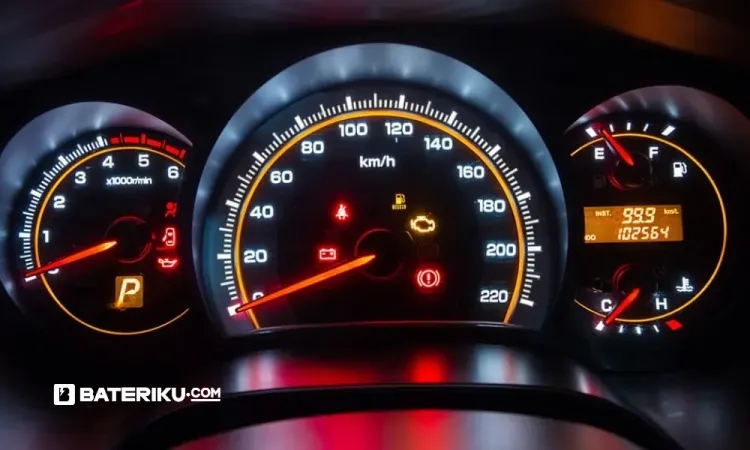In the world of modern automotive technology, the dashboard plays a crucial role not just as a control hub, but as an early warning system that communicates your vehicle’s condition directly to you. The icons or warning lights on the dashboard act as the voice of your car, alerting drivers to possible issues, system statuses, or important reminders.
When a symbol lights up, it’s sending a message whether it’s a warning, a notification, or an active system indicator. Without understanding these dashboard icons, drivers risk missing early signs of damage or potential safety hazards that could have been prevented.
Since cars can’t literally talk, these icons serve as a universal language between driver and machine, helping ensure your vehicle remains safe, efficient, and roadworthy.
9 Dashboard Indicator to Watch Before Your Car Breaks Down
Below is a list of some of the most important dashboard icons that every driver should recognize. Each light carries its own meaning and functions as an early signal before a minor issue becomes a serious problem that could affect your safety.
If any of these indicators light up while driving, don’t ignore them, they often point to issues with major systems like the engine, brakes, battery, or cooling system. Quick action can save you from costly repairs and keep you safe on the road.
1. Check Engine Light

Indicator Description: An engine-shaped icon, sometimes with the words “CHECK ENGINE.”
When it lights up:
- Appears when the Engine Control Unit (ECU) detects a fault in the engine or emission system.
- A flashing light often indicates a more serious malfunction.
Possible issues:
- Could range from minor issues like a loose fuel cap to major engine faults or a failed oxygen sensor.
- Ignoring it can lead to severe engine damage.
Why it happens
- Engine sensors detect readings outside normal range.
- ECU identifies a combustion or performance issue.
What to do
- Visit a workshop equipped with an OBD diagnostic tool to pinpoint the error.
If ignored
- Engine may go into limp mode or lose power.
- Risk of complete engine failure.
The Check Engine light often raises questions for every car and motorcycle owner. It can be triggered by issues as minor as a loose engine oil cap or as serious as a major problem within the heart of your engine. To resolve this issue, you should consult a skilled and experienced mechanic who is truly capable of diagnosing your vehicle’s engine accurately.
2. Battery Warning Light

Indicator Description: A red or yellow battery symbol.
When it lights up:
- The car’s charging system detects a problem usually with the alternator or battery.
Possible issues:
- A weak or dying battery.
- Alternator not charging properly.
- Corroded or loose battery terminals.
What to do:
- Stop safely and inspect battery connections.
- Test your alternator and battery at a workshop.
If ignored:
- The car could die suddenly while driving, requiring towing.
For the battery-shaped indicator light, its meaning is quite clear it signals that your vehicle may be experiencing a battery-related issue, whether the battery is weak or damaged. Don’t be fooled if your car still starts; this warning light comes on to alert you that your battery may soon fail. Ignoring this indicator for an extended period can lead to a situation where your car won’t start at all. A small issue left unattended can easily turn into a much bigger problem.
3. Brake System Warning Light

Indicator Description: A circle with an exclamation mark inside or the word “BRAKE.”
When it lights up:
- The parking brake is still engaged, or there’s a brake system fault (like low brake fluid or worn pads).
Possible issues: -Reduced braking power or total brake failure.
What to do:
- Ensure the parking brake is released.
- Check brake fluid levels.
- Visit a mechanic for brake inspection.
If ignored:
- Slower brake response and increased risk of accidents.
We often talk about 0–100 km/h acceleration, but did you know that 100–0 km/h braking is just as important? If your braking system is in good condition from the brake pedal to the brake pads there’s nothing to worry about. However, if your brake warning light turns on, it’s time to be cautious.
Brakes are the most fundamental safety feature in any motor vehicle. If the brake warning light indicates an issue, such as a leak in the brake hose or a problem with the brake caliper, you must take immediate action. Delaying repairs could compromise your safety and lead to more serious damage.
4. Oil Pressure / Engine Oil Light
 Indicator Description: An oil can with a drop or the word “OIL.”
Indicator Description: An oil can with a drop or the word “OIL.”
When it lights up:
- Indicates low oil pressure or insufficient engine oil.
Possible issues:
- Low oil level, failed oil pump, or oil leak.
What to do:
- Stop safely and let the engine cool.
- Check and top up engine oil.
- If the light stays on, visit a workshop immediately.
If ignored: Engine may seize or suffer internal damage, leading to costly repairs If you’ve been maintaining your car properly, this warning light usually isn’t a major concern. However, the oil indicator light can turn on due to two main reasons: low oil pressure or insufficient engine oil level.
If the oil warning light comes on while you’re driving, pull over safely and let the engine cool down for about 10–15 minutes before checking your engine oil level. If it’s low, top up the engine oil and try starting the car again. If the indicator turns off, you’re in luck.
However, if the light remains on, you should immediately consult a nearby mechanic. Ignoring this warning can cause serious engine damage, such as scratched engine components or even a seized (jammed) engine.
5. Engine Temperature Warning Light
 Indicator Description: A thermometer symbol over waves or a red temperature gauge.
Indicator Description: A thermometer symbol over waves or a red temperature gauge.
When it lights up:
- The engine is overheating or the cooling system has failed.
Possible issues:
- Low or leaking coolant, broken radiator fan, or faulty thermostat.
What to do:
- Stop the vehicle and turn off the engine.
- Check coolant level after cooling down.
- Call for roadside assistance if the issue persists.
If ignored:
- Risk of blown head gasket or cracked engine block.
The image that looks like a flag over water actually represents a thermometer, indicating your engine’s temperature warning light. When this light turns on or when the temperature gauge needle rises toward the thermometer symbol it means your engine is under stress and overheating.
This usually happens when the engine coolant level is low or there’s a leak in the cooling system, such as a damaged hose. You should stop your vehicle immediately, as excessive heat can cause serious engine damage, particularly to the pistons and gaskets, which could lead to costly repairs.
The safest solution is to call a tow truck to avoid further damage and ensure your car remains in good condition.
6. Traction Control Light

Indicator Description: A car with squiggly lines beneath it (usually yellow/orange).
When it lights up:
- The system detects wheel slip due to slippery conditions.
Possible issues:
- Normal activation on wet roads, but if it stays on during dry conditions, it could indicate a faulty sensor.
What to do: -Drive carefully on wet surfaces. -If it stays on in normal conditions, have the sensors checked.
If ignored:
- Reduced traction and vehicle stability in slippery conditions.
The yellow or orange icon showing a car with wavy skid marks indicates that your vehicle’s traction control or stability control system is active. This system helps prevent your car from skidding, especially on wet or slippery roads.
If you accelerate quickly during rainy conditions, this light may flash meaning the system is automatically adjusting power or braking to help keep your vehicle stable.
However, if this icon stays on continuously during dry or normal weather, it could indicate a fault in the speed or traction sensors. In that case, you should have your car inspected by a qualified mechanic as soon as possible.
7. Tire Pressure Warning Light

Indicator Description: A tire symbol with an exclamation mark in the center.
When it lights up:
- Tire pressure is too low or there’s a sensor fault.
Possible issues:
- Underinflated tires, leaks, or faulty TPMS sensors.
What to do:
- Check and adjust tire pressure according to manufacturer recommendations.
- Inspect for punctures or damage.
If ignored -Increased fuel consumption, uneven tire wear, or tire blowout.
Maintaining the correct tire pressure is very important as tires are the only components that connect your vehicle to the road surface. If the tire pressure is too high or too low, it can cause poor handling, reduced driving comfort, and increase the risk of accidents. In addition, improper tire pressure can lead to damage on the tire sidewalls, increasing the risk of a blowout and resulting in unnecessary repair costs.
8. ABS (Anti-Lock Braking System) Light

Indicator Description: The letters “ABS” inside a circle.
When it lights up:
- The ABS system has a malfunction possibly a faulty sensor or hydraulic issue.
Possible issues:
- Regular braking still works, but the ABS safety feature is disabled.
What to do:
- Drive cautiously and visit a workshop for diagnostics.
If ignored:
- Higher risk of skidding during hard braking or on wet roads.
ABS is an important technology in a car’s braking system that helps the vehicle stop without skidding, especially on slippery roads or during sudden braking. So, even if your driving isn’t as sharp as Max Verstappen, Lewis Hamilton, or Valentino Rossi, the ABS system still plays a major role in ensuring safety. Make sure this system is always in good working condition so your car’s brakes remain responsive and stable in any driving situation.
9. SRS Airbag Warning Light

Indicator Description: A seated figure with a circle in front (representing the airbag).
When it lights up:
- Appears briefly at startup for a self-check.
- If it stays on, there’s a problem with the airbag system.
Possible issues:
- Loose wire connections, faulty sensors, or damaged airbag modules.
What to do:
- Have the system scanned with an OBD-II diagnostic tool.
- Avoid DIY repairs airbags can deploy accidentally if mishandled.
If ignored
- Airbags may fail to deploy in a crash or deploy unexpectedly, risking injury.
The SRS Airbag icon is one of the most important symbols that should never be ignored. It’s not just a warning, but a sign that your vehicle’s main safety system may be malfunctioning. If it stays illuminated, immediately have your car inspected at a certified workshop or service center, such as bgarage, to ensure the airbag system is fully functional before continuing your drive.
Bateriku Icon

Indicator Feature: The letter B with a lightning bolt and the text BATERIKU.COM in black on a green background.
When the Indicator Lights Up:
- This indicator means your car has broken down by the roadside, and you need immediate assistance. Contact Bateriku right away.
How to Contact:
- Go directly to Bateriku to get immediate assistance.
Why Contact Bateriku: if you are facing any of the following issues
- Car battery is dead and needs immediate replacement.
- Car has broken down and requires towing service.
- Lost keys or car is locked.
- Out of fuel.
Consequences If You Don’t Take Action:
- You and your car will be stranded by the roadside.
- Risk being overcharged thousands by unlicensed touts.
- Safety risks (especially on highways or roadside areas).
- Fear and anxiety (especially at night or in isolated areas).
From the roadside to your doorstep, Bateriku is always ready to help. Fast, easy, and reliable.
When Warning Icon Glow Bateriku Is Ready to Go

